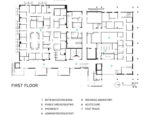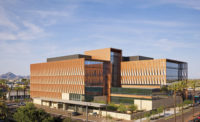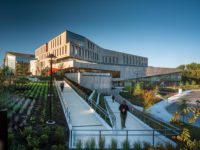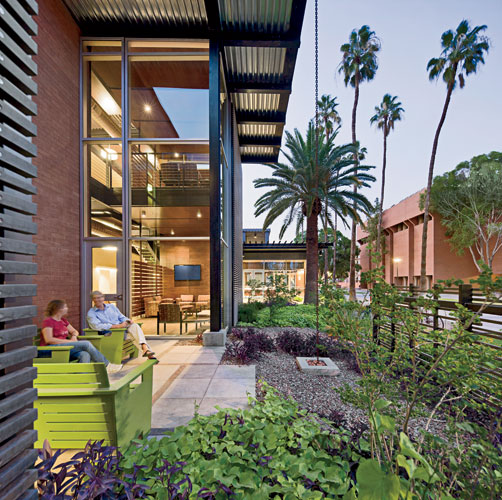Arizona State University Student Health Services
A Prescription for Campus Care: Lake|Flato renovates and expands an outdated health-services facility at Arizona State University, Tempe.






Architects & Firms
Tempe, Arizona
Built as two structures in 1953 and 1968, the Health Services'Tempe Building (HSTB) at Arizona State University (ASU) had become inefficient and out of rhythm with the vibrant, growing campus around it.
Designed by San Antonio'based Lake | Flato in collaboration with architect of record Orcutt | Winslow of Phoenix, the overhauled, 36,900-square-foot HSTB is light-filled, inviting, and designed for LEED Platinum certification. Its gardenlike environment is a refuge for the campus's 60,000 students when they need medical treatment and guidance.
Located in the historical heart of ASU, the HSTB is adjacent to three century-old structures, all on the National Register of Historic Places'Old Main, the University Club, and the Piper Writer's House'and it faces the campus's main pedestrian corridor, Palm Walk, which is dotted with palm trees as old as the landmarks.
The architects aimed to engage both the old and new structures and Palm Walk with a dynamic, welcoming building that relates to its context in terms of texture, color, scale, and landscaping. Optimizing the site, they combined the two existing structures into one, partially razing the single-level 1953 wing and expanding it into a two-story, 20,000-square-foot clinic on the south, while renovating the bilevel 1968 building on the north. Then they created a series of gardens and small plazas that face the central campus.
Our approach to design starts with the notion that humans need a meaningful connection to the natural environment,' says Lake|Flato's Andrew Herdeg. To ensure this, the two firms employed a number of strategies, orienting the building east toward Palm Walk for morning daylight and creating xeriscape gardens, whose desert flora fits in with the surrounding context. In addition, the verticality of the structural steelwork responds to the thrusting palms, and outdoor waiting areas spread out from the facility toward the pedestrian walk; these are shaded by angled overhangs and form lushly planted oases between them.
The entry pavilion is the center's highly visible 'front door,' providing a clear circulation pattern into and through the new structure. A centralized, easy-to-monitor entrance also allows staff to keep track of visitors, while supporting way-finding and care delivery.
The double-height, sunlit lobby, with its polished aggregate-concrete floor, centers on a concierge desk where students are greeted. Orcutt | Winslow, which was responsible for the interiors, created a wraparound desk finished with bear grass encased in backlit acrylic. Whenever possible, the design team chose sustainable materials and finishes in natural colors to reaffirm the indoor-outdoor theme, while subtly integrating ASU's school colors, maroon and gold.
During the planning stage, students favored a facility with a noninstitutional atmosphere and requested ample electrical outlets in waiting areas for plugging in and recharging electronic devices. Okland Construction, the general contractor, even mocked up areas in its Phoenix facility to test and refine these suggestions.
The staff immediately responded to the increased efficiency, says Dr. Allan L. Markus, ASU's health-services director. 'The building design assists the health-center staff to decrease wait times for appointments and ancillary services,' he adds. Ultimately, Markus says, 'the facility has made an impression on our students about coming to the health center'not just when they are feeling ill but also to maintain their health.'
David M. Brown is a freelance writer based in Mesa, Arizona.
Size: 36,900 square feet (15,570 renovated, 21,330 new)
Completion date: June 2012
Total construction cost: $7.6 million
PeopleOwner: Madrilenian Public Health Service. Department of Health, Autonomous Community of Madrid Architect: Personnel in architect's firm who should receive special credit: Ted Flato, FAIA, Designer (registered architect) Orcutt|Winslow: Bill Sheely, Partner in Charge, AIA, ACHA, NCARB (registered architect) Architect of record: Orcutt | Winslow Design architect(s): Lake | Flato Interior designer: Orcutt | Winslow Engineer(s): Structural Engineering: Caruso, Turley Scott Inc. MEP: Van Boreum & Frank Associates, Inc. Cost Estimating: Rider Levett Bucknall Consultant(s): Landscape: Ten Eyck Landscape Architects Other: General contractor: Okland Construction Photographer(s): Renderer(s): Orcutt | Winslow Infuse Studio CAD system, project management, or other software used: Archicad |
ProductsStructural system Manufacturer of any structural components unique to this project: Milling Machinery Inc Exterior cladding Metal Panels: Kovach Metal/glass curtain wall: Arcadia Precast concrete: Southwest Architectural Castings Wood: European Techniques EIFS, ACM, or other: Owens Corning (insulation), GreenGuard (insulation) Curtain wall: Arcadia Other cladding unique to this project: Trex Roofing Windows Glazing Doors Metal doors: Southwestern Hollow Metal, Curries Wood doors: VT Industries Hardware Closers: Architectural Builders Hardware Exit devices: Stanley Pulls: Best/Trimco Security devices: Stanley Interior finishes Suspension grid: Armstrong Cabinetwork and custom woodwork: European Techniques Paints and stains: Frazee Wall coverings: American Clay Paneling: European Techniques Plastic laminate: Wilsonart, Doellken Solid surfacing: Staron Floor and wall tile: Daltile Resilient flooring: Armstrong, Johnsonite Carpet: Shaw Special interior finishes unique to this project: Cubicle Curtains: Architex Furnishings Reception furniture: Steelcase Chairs: Steelcase Tables: Steelcae Lighting Downlights: Delta Light, Prescolite Task lighting: Philips Forecast Exterior: Hubbell Dimming System or other lighting controls: Watt Stopper Conveyance Plumbing Energy Other unique products that contribute to sustainability: |







